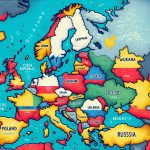
The Polish language has a fascinating history that goes back to the Proto-Slavic period. It has changed a lot over time, influenced by major events and changes in society.
In this exploration, we’ll look at how important eras like the time of the Piast Dynasty, the Renaissance, and the Enlightenment have shaped the Polish language. These periods were crucial in its development.
As we dive into the history of Polish, we’ll also think about where it’s heading in today’s global world.
The Proto-Slavic Beginnings
The Polish language, alongside other Slavic tongues, finds its roots in the Proto-Slavic language. This language came to life in Eastern Europe during the early Middle Ages through a mix of linguistic and cultural exchanges. Initially, Proto-Slavic was quite unified, representing a time when Slavic languages hadn’t yet branched out. Originating from the broader Indo-European family, Proto-Slavic carved out its identity by developing distinctive sounds, word structures, and sentence patterns. These changes set it apart from its ancestors.
A key factor in the evolution of Proto-Slavic was how Slavic tribes spread across different regions. As they moved, they encountered and absorbed elements from neighboring languages and cultures. This process of mixing and adapting was crucial in shaping the early stages of the Slavic languages, including Polish.
Consider the way Proto-Slavic influenced Polish phonology and grammar. For example, the consistent use of soft and hard consonants in Polish can be traced back to Proto-Slavic’s phonetic innovations. Similarly, the complex system of verb aspects in Polish, where verbs can signify completed or ongoing actions, also has its origins in Proto-Slavic.
Understanding this foundational phase is essential for anyone looking to grasp the intricacies of the Polish language. It sheds light on why Polish sounds and behaves the way it does today, offering a window into the past before Slavic languages took their separate paths. This journey from a unified Proto-Slavic to the diverse Slavic languages we know today is not just a linguistic evolution but a fascinating tale of migration, interaction, and transformation.
Early Medieval Divergence
In the early medieval era, a significant shift happened with the Proto-Slavic language. This was the language that many Slavic tribes shared before it began to split into different languages, including Polish. This split didn’t happen overnight. As Slavic tribes moved and settled in new areas, they became isolated from each other. This isolation led to changes in how they spoke. Over time, these small changes added up, creating distinct languages.
Think of it like this: if you’ve ever played the game of ‘telephone,’ where you whisper a message to the person next to you, and they pass it on, by the time it reaches the last person, the message often changes completely. Now, imagine this game played over generations, with tribes moving further apart and rarely interacting. The way they speak – their dialect – changes bit by bit, eventually becoming so different that it’s considered a new language.
The creation of new languages wasn’t just about geography. Politics played a role too. As tribes settled into specific areas, political boundaries formed. These boundaries often influenced how much tribes interacted with each other and with neighboring groups. The more isolated a tribe became, the more unique their language grew. This was the case with the Polish language, which began to develop its own set of sounds (phonology), word formations (morphology), and sentence structures (syntax) that set it apart from other Slavic languages.
An interesting thing to note is how languages can borrow from each other. For the Polish language, being in close proximity to other tribes and nations meant picking up words and phrases from them. This blending of languages added to the richness and complexity of Polish.
The Piast Dynasty Influence
The Piast dynasty played a crucial role in the development of the Polish language. During their reign, the Polish language started to show its unique characteristics, moving away from its Proto-Slavic origins. This was a time when Poland began to form as a nation-state, and the Piast rulers were at the forefront, not just politically but also in shaping the country’s cultural identity.
One of the key impacts of the Piast dynasty was how they promoted the use of Polish in government and law. This wasn’t just a random choice. By doing so, they were laying down the early bricks for the Polish language to become standardized. Think of it like setting the rules of a game – once everyone knows how to play, things run smoothly. This move towards using Polish in official settings was a game-changer. It meant that over time, people across different regions of Poland started to speak and write in a way that was more uniform. This is how the foundation for a common Polish linguistic identity was laid.
Now, let’s talk about why this is important. Language is more than just words; it’s a reflection of a society’s culture, history, and identity. By fostering a unified language, the Piast dynasty wasn’t just making administrative tasks easier. They were bringing people together, creating a sense of national identity. This was crucial for a country that was just beginning to define itself.
Moreover, this emphasis on the Polish language set the stage for it to evolve independently, even as the Renaissance brought about significant changes in art, science, and literature across Europe. The Polish language, with its solid foundation laid during the Piast dynasty, was able to absorb new influences while retaining its unique character.
In a nutshell, the Piast dynasty did more than just rule. They were architects of the Polish language as we know it today. By pushing for the use of Polish in official matters, they ensured that the language developed in a way that unified the country. This wasn’t just about making laws or running a government; it was about weaving the very fabric of Polish identity. Through their efforts, the Polish language became a strong pillar supporting the nation’s culture and heritage, something that continues to hold true today.
Renaissance and Language Flourishing
During the Renaissance, the Polish language truly came into its own, expanding and evolving in ways that had a lasting impact. This was a time when literature, science, and philosophy were all blooming, creating the perfect conditions for the Polish language to grow and become more sophisticated. One game-changer was the introduction of the printing press to Poland in the late 15th century. Imagine, for the first time, Polish books and documents could be produced quickly and in large quantities. This not only made the language more accessible to people but also helped make it more consistent across the board.
Let’s talk about the people who really pushed Polish to new heights—scholars and poets. They were riding the wave of humanist ideals, which was all about reviving classical learning and emphasizing the value of human beings. These thinkers started writing in Polish about all sorts of things, from epic poetry to scientific treatises. This wasn’t just a bunch of new words; it was about lifting Polish to a level where it could stand shoulder to shoulder with Latin, the go-to language for serious discourse at the time.
Enlightenment and Modern Polish Evolution
During the Enlightenment, the Polish language took a significant leap towards what we consider modern Polish today. This period was all about making big changes. Think of it as a major language makeover. People wanted to make Polish more Polish, getting rid of words borrowed from other languages and bringing back old Slavic words that had been forgotten. This was a way to strengthen the country’s identity through language.
One key figure in this transformation was Samuel Linde. Imagine him as a language superhero, taking on the huge task of creating dictionaries that were more than just books of words. These dictionaries set the rules for how words should be spelled and how sentences should be structured, making Polish easier for everyone to understand and use. This was a big deal because it helped to unify the language, making it possible for more people to communicate with each other effectively.
The Enlightenment wasn’t just about cleaning up the language, though. It also introduced new ideas about the importance of reason and the value of every individual. This shift in thinking made way for literature written in Polish that spoke to the everyday experiences of the middle class, not just the elite. It was like opening the doors to a vast library of knowledge for more people, which was pretty revolutionary at the time.
Thanks to these efforts, Polish evolved into a language capable of expressing complex ideas and uniting a nation. It became a tool for education, a way to share new scientific discoveries, and a means for people to discuss the big questions of the time. This period laid the groundwork for the Polish language to be a powerful means of communication and a source of national pride in the modern world.
Conclusion
The Polish language has an interesting history that goes way back. It started from something called Proto-Slavic, which is like the ancient grandparent of Polish. Over hundreds of years, it changed a lot, especially during important times like when the Piast Dynasty was in charge, during the Renaissance, and then again in the Enlightenment period.
These changes weren’t just random; they happened because of what was going on in society and politics at the time. So, when we look at how Polish has evolved, it’s really a story about how the people who speak it have changed too. It’s pretty cool to see how a language can show us so much about a country’s history and culture, and how it helps keep that culture alive and kicking.






Comments are closed.